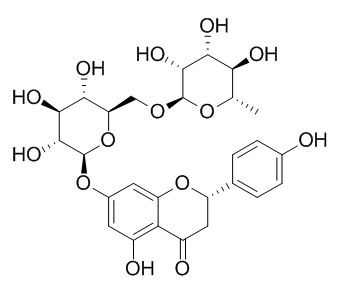Natural Products
Narirutin
| Catalog No. | CFN99543 |  |
| CAS No. | 14259-46-2 | |
| Molecular Weight: | 580.53 | |
| Molecular Formula | C27H32O14 | |
| DBs | [PubChem]:274950610 [ChEMBL]:28705 [PCIDB]: |
Standard InChI:
InChI=1S/C27H32O14/c1-10-20(31)22(33)24(35)26(38-10)37-9-18-21(32)23(34)25(36)27(41-18)39-13-6-14(29)19-15(30)8-16(40-17(19)7-13)11-2-4-12(28)5-3-11/h2-7,10,16,18,20-29,31-36H,8-9H2,1H3/t10-,16-,18+,20-,21+,22+,23-,24+,25+,26+,27+/m0/s1
Biological Activity
Narirutin has anti-inflammatory effect in a murine model of allergic eosinophilic airway inflammation, the mechanism is likely to be associated with a reduction in the OVA-induced increases of IL-4 and IgE, suggests that narirutin may be an effective new tool in the treatment of bronchial asthma.[1]
Citrus narirutin fraction (CNF), contained 75% of narirutin, co-administration of CNF with alcohol can alleviate alcohol induced liver damage through preventing lipid formation, protecting antioxidant system and suppressing productions of pro-inflammatory cytokines.[2]
Narirutin has inhibition on cuprizone-induced apoptosis of oligodendrocyte.[3]
Product
References
[1] Funaguchi N, Ohno Y, Bu L B L, et al. Clin Exp Pharm P, 2007, 34(8):766-70.
[2] Park H Y, Sang K H, Eom H, et al. Food Chem Toxicol , 2013, 55(3):637-44.
[3] Zhan R, Watanabe K.. Neurosci Res, 2011, 71(3):e323.
[4] Lee S, Khoo C S, Pearson J L, et al. J Aoac Int, 2009, 92(3):789-96.
Product Use Citation





